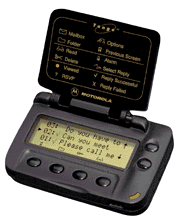
 |
JPL's Wireless Communication Reference WebsiteChapter: Network Concepts and Standards, Paging |
 In August 1996 Motorola's Advanced Messaging Group (AMG) the two-way messaging application that allows users to navigate the Internet. Through successful demonstrations in five metropolitan areas (Boston, MA; Chicago, IL; Dallas/Fort Worth, TX; southern Florida, Washington, DC), Motorola has proven that Tango®, the world's first two-way high-speed wireless messaging device, is capable of originating queries and receiving information from the World Wide Web. Web information accessible today to Tango® users includes business news, airline flight information, weather and sports scores.
In August 1996 Motorola's Advanced Messaging Group (AMG) the two-way messaging application that allows users to navigate the Internet. Through successful demonstrations in five metropolitan areas (Boston, MA; Chicago, IL; Dallas/Fort Worth, TX; southern Florida, Washington, DC), Motorola has proven that Tango®, the world's first two-way high-speed wireless messaging device, is capable of originating queries and receiving information from the World Wide Web. Web information accessible today to Tango® users includes business news, airline flight information, weather and sports scores.
"This demonstration of Web connectivity is the result of Motorola's drive to show the two-way wireless messaging market the kinds of applications Tango® and the
Motorola succeeded in linking the Tango® to the Web by utilizing a Web server, SkyTel's 2-Way service -- based on Motorola's
Also, Motorola's Messaging Systems Products Group (MSPG), in cooperation with the Personal Communications Industry Association (PCIA), made available the TDP (Telocator Data Paging) suite of protocols available free of charge to wireless application developers on the World Wide Web. The TDP protocol suite allows wireless product users to send files, pictures and two-way messages over one- and two-way paging networks. The protocol suite, in hypertext (HTML),
Specifications:
General Information |
|
|---|---|
| Tango Receiver |
|
| Frequency Bands: | 940 - 941 |
| Channel Spacing: | 25 kHz |
| Bit Rate: | 6400 bps |
| Signaling: | 4 level FSK at 6400 bps |
| Frequency Deviation: | +/- 2400 Hz binary +/- 800 Hz and +/- 2400 Hz for 4 level |
| Paging Sensitivity: | 14 micro-V/m address only, best position (6400) |
| Image Rejection: | 35 dB |
| Spurious Rejection: | 40 dB |
| Selectivity: | 60dB at +/- 50 kHz |
| Frequency Stability: | 1 PPM from -10C to +50C (REF. at +25C) |
| Temp. Spec: | -10 to +50 degrees C |
| Frequency: | Synthesized |
| Spurious Emissions: | 5 nW |
| 1 MHz Blocking: | 80dB |
| Tango Transmitter |
|
| Frequency Bands: | 901 - 902 |
| Channel Spacing: | 12.5 kHz |
| Bit Rate: | 9600 bps |
| Signaling: | 4 level FSK at 9600 bps |
| Frequency Deviation: | +/- 800 Hz and +/- 2400 Hz for 4 level |
| Emissions: | meets Narrowband PCS FCC specs |
| Power Into Antenna: | 1 W |
| Frequency Stability: | 1 ppm |
| Frequency: | Synthesized |
| Weight with Batt.-Belt Clip: | 5.6 oz (grams) |
| Size: | 3.5" x 2.4" x 1.12" (9.4 cu in) |
| Battery Life: | Approx. 14 days, 5 pages per day and a collapse value of 3 |
| Battery: | One 1.5V AAA size alkaline |
| Alert Tone Loudness: | 72 dB SPL at 30 cm |
| Alert Tone Duration: | 12 sec +/- 0.5sec, unless manually reset |
| Alert Tone Frequency: | 3200 Hz |